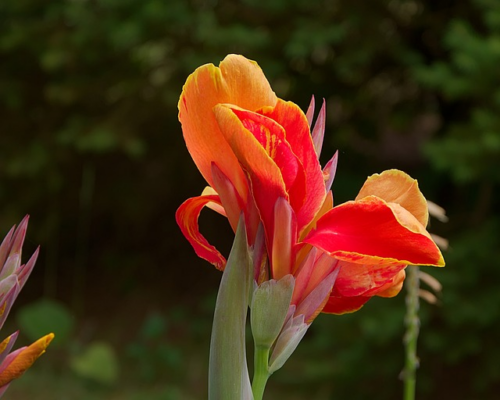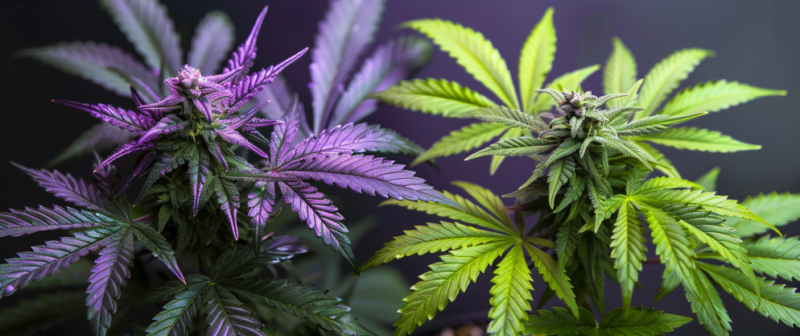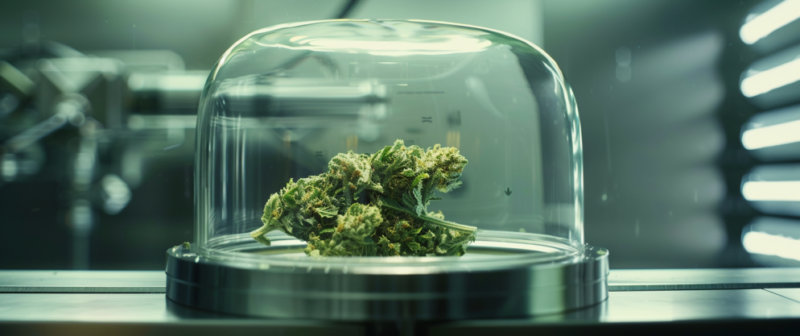Most people think that cannabis and mushrooms are the two main options for psychoactive substances that come from nature. But another substance is becoming more popular.
The sceletium tortuosum plant, or Kanna, is a South African plant now becoming popular as a botanical supplement. Native people and traditional natural healers have used it for hundreds of years for various illnesses. Below, we will talk about Kanna and look at it more closely to see if all the talk about it is true.
What is Kanna?
Kanna is a type of succulent native to some parts of South Africa. As this plant grows, it will eventually look like a bush, and its leaves will be flat and full of water. In the end, these leaves will cover the ground in the desert. At different times of the year, yellow or pink flowers will grow on the plant.
The plant is known as kauwgoed and channa, but its scientific name is sceletium tortuosum. Kanna can be bought as a powder, an oil, or just as dried leaves that can be brewed into tea. On the other hand, Kanna extract seems to be the most popular way to use this product.
Kanna is not a controlled substance. Instead, it is an herbal medicine often compared to MDMA or psychedelics. However, taking sceletium tortuosum extract won’t make you “trip” or change your state of mind. Instead, it helps calm the mind and get rid of stress simultaneously. Since it makes people feel better in general, it is a great choice as a supplement for people with anxiety and depression.
History of the Kanna plant
The Kanna plant has been around for thousands of years, and it has always grown naturally in the area that is now called South Africa. The prehistoric people who lived in the area were the first to learn about its benefits. As a result, they started using it in various healing rituals and ceremonies. So, by the time Dutch merchants got to South Africa, Kanna had already been grown for a long time and was ready to be sold as a crop.
This South African medicinal plant was first shown to the world in a painting from 1685. In 1662, a Dutch colonial governor named Jan van Riebeeck talked about trading with the local people for something he called “Kanna.” The Dutch were willing to trade sheep for the plant because it was in high demand.
In 1685, a Dutch artist painted a picture of a plant and wrote about how the local people used it. The story says that native people would store the plant in sheepskins that had been stitched together and then grind the roots, stems, and leaves between stones. Because most people ate the plant by chewing it, the Dutch gave it the name kougoed, which means “chew well.”
Kanna would make its way to Europe for several decades, and many people would talk about its health benefits like ginseng. Chewing the plant’s leaves was the most common way to use it until the late 1700s when smoking it became popular.
How does Kanna work?
Kanna has many different alkaloids, just like kratom and other plant-based supplements. These alkaloids have effects on the brain that may increase the flow of serotonin while decreasing the activity of signals in the brain that cause anxiety.
Researchers still think that 30 or more different alkaloids cause the effects of the Sceletium plant. For example, Mesembrine, Mesembrenone, and Mesembrinol are three essential alkaloids in Kanna.
People have been using the plant for hundreds of years, but scientists have only done a small amount of research on its biological and medical properties. Research on the plant has shown that the most active part is an alkaloid called mesembrine.
What are the effects of Kanna?
Due to the potent alkaloids it contains, Kanna has the potential to make the brain feel psychedelic in many ways. These alkaloids stop neurons from talking to each other. Kanna users say they feel less angry and anxious after using it, and some say they also feel slightly happier than before. Even though the effect is not as strong as that of so-called “hard” drugs like LSD or MDMA, it is still noticeable.
People say that in the past, hunters would take a sceletium tortuosum extract to help them calm down before going on a hunt. This would make them less tense and anxious. Kanna leaves could have a similar effect in the modern world on many things that cause anxiety, like taking a test, doing a hard task, or even feeling overwhelmed.
People have always said that Kanna products make people feel excited and high. But this story shows that even small amounts of Kanna have very different effects. Some possible benefits of using cannabis are less anxiety and stress, a boost in self-confidence, and a sense of well-being, which can lead to deeper social connections. In addition, some effects are euphoria and a calmness similar to what you feel when you meditate.
Some people who have tried Kanna say that it relaxes them to the point where they can focus on their inner thoughts and feelings or the beauty of nature if they want to. Kanna has also been shown to make people feel more sexually aroused and to make the skin more sensitive to touch.
Potential Benefits of Using Kanna

Kanna has powerful natural properties that have led to much research into it as a possible treatment for various illnesses. Even though more research needs to be done before any conclusions can be made about the effectiveness of Kanna in treating different conditions, the studies that have been done so far are pretty convincing.
Stress relief
Kanna users say that using the plant results in reduced stress and improved sleep. Research shows that taking Kanna makes the amygdala, the part of your brain that controls the body’s fear response, use less of its processing power. So, if you limit what the amygdala can do, you won’t feel as much stress or worry about how something will turn out.
According to a study with a double-blind design, those who took Kanna instead of a placebo had a big drop in the severity of their anxiety symptoms. The results were similar to what was seen with SSRIs and other anti-anxiety drugs (selective serotonin reuptake inhibitors).
There is a chance that mesembrine and full Sceletium tortuosum extract could work as natural antidepressants. Participants in a clinical trial who took Sceletium tortuosum extract said they slept better and felt less stressed than those who didn’t. Studies done by psychiatric professionals in South Africa also found that Kanna helped improve the symptoms of depression and anxiety.
Anxiety
Anxiety can be thought of as the body’s normal response to something stressful. In a 2011 study, Kanna extract was shown to raise serotonin levels and lower the activity of the PDE4 enzyme by working on the body’s central nervous system.
Low levels of serotonin are linked to feeling sad and anxious more often. Serotonin is a neurotransmitter in the brain that affects mood and how people act around each other.
An enzyme called PDE4 breaks down a chemical messenger called cAMP. This would typically cause the amount of brain-derived neurotrophic factor to rise. By inhibiting PDE4, one can bring about a decrease in cAMP levels, which may result in an improvement in mood as well as an anxiety reduction.
Depression
One in ten adults in the United States often shows signs of depression, according to the Centers for Disease Control and Prevention (CDC). Research suggests that Kanna extract may have antidepressant properties that come from the plant itself. This is interesting because there are now a lot of synthetic drugs for depression.
In a 2014 study, non-depressed participants who took 25 milligrams of Sceletium tortuosum did better on the Hamilton depression rating scale than those who took a placebo. A 2013 study found that patients who took 10 milligrams of Kanna felt “uplifted spirits.”
Inflammation reduction
Kanna is not usually used to treat inflammation, but studies on animals have shown that some of its parts can reduce inflammation. Because of this, the plant might be able to ease the pain or other symptoms caused by the inflammation. Still, since there have not been any specific studies done on these effects, it is hard to say how effective it might be or how much substance someone would need to take to feel them.
When considering the benefits of any natural supplement, it is essential to remember that every person’s body is different. So, Kanna may be very effective for one person, but it may not have the same effect on your body. Also, the more Kanna you use, the less effective it will be, so you will have to take more of it.
Even so, it will probably take a while to get used to Kanna’s effects to a large degree. This is because Kanna is most useful in certain situations rather than just being a way to get high.
Different ways to use Kanna
Kanna can come and be used in a few different ways. For example, Kanna tea in the morning may be a nice and energizing way to start the day. Adding Kanna tinctures or powders to your daily smoothie is also simple. Kanna extract, on the other hand, is almost always sold in capsules. Because the FDA hasn’t approved Kanna as a product, there aren’t any rules about how much to take.
Preparing Kanna
It is known that the Kanna plant has alkaloids, but it needs to be properly processed before it can be used. Oxalic acid is found in Kanna, as it is in most plants from the genera Sceletium and Mesembryanthemum. People sensitive to oxalic acid know it can cause many irritation and allergies. It has to go through a fermentation process to break down oxalic acid.
Traditionally, the plant is collected in October, at its strongest. The plant parts are then crushed between two rocks and put in a sealed container for a few days to “ferment.” In the past, this job was done with animal skins or sacks made of hemp.
After two or three days, the bag is cut open, and the contents are thoroughly mixed and blended after the container has been exposed to sunlight. After the bag has been opened again, it is checked for leaks and then sealed back up. After a week, the Kanna is removed from the bag and put on the ground to dry in the sun. Once the plant has dried, it is ground into a powder or cut into smaller pieces.
Another way to prepare Kanna is by roasting it over flames until completely dry.
Preparing Kanna extract
Kanna alkaloids dissolve best in alcohol because they have a lot of water. If you soak Sceletium tortuosum’s fine powder in food-grade ethanol or 99% isopropyl alcohol, the alkaloids could move from the plant material into the solution. This will ensure that there are many alkaloids in the solution.
After a certain amount of time, the solution is filtered, and the powder is squeezed well before being thrown away. The ethanol or isopropyl must then be evaporated entirely out of the extract. Any alcohol left over after distillation is dangerous and should not be drunk.
Once the solution has been cleaned well, the end product will be a tar resin high in alkaloids. You can mix this extract with powdered Kanna or the parts of other plants. You can also keep it in the form of resin.
What does Kanna consist of?
Kanna contains about 1–1.5% total alkaloids. Both mesembrine and mesembrenone, the two main components, have been successfully isolated, with mesembrine giving 0.86 % and mesembrenone giving 0.2%. Tortuosamine is one of the other six alkaloids that are only found in tiny amounts.
Alkaloids like mesembrine, mesembrenone, mesembrenol, and tortuosamine are thought to be what give the plant its psychoactive effects. However, there is a chance that the plant also has tryptamines, since methyltryptamine (MMT) and N,N-dimethyltryptamine (N,N-DMT) have been found in a different species of Delosperma, which is a close relative in the same family.
Oxalic acid is also in the plant’s leaves. The leaves and stalks of the plant contain mesembrine, which has the empirical formula C17H23NO3. The plant’s roots have 0.3% mesembrine, while the leaves, stems, and flowers have 0.86%. Mesembrine blocks the reuptake of serotonin and has some inhibiting effects on phosphodiesterase 4, but these effects aren’t as strong.
How much Kanna should you take?
Kanna Powder
Kanna is taken orally as a powder, which should be held for about ten minutes. After the saliva has built up in the mouth, it can be swallowed. After 30 minutes, two grams of Kanna powder can make you feel calm and relaxed, while five grams is enough to calm anxiety. More entheogenic effects (euphoria, visions) happen at higher doses.
Other effects, like mydriasis, analgesia, loss of appetite, tingling in the tongue, a gag reflex, a stuffy feeling in the head, and noises in the ears, can be caused by doses as low as five grams (equal to 150 mg of mesembrine) and as high as 150 mg.
Kanna Extract
For the cognitive effects of Zembrin, a commercial extract of Sceletium tortuosum from South Africa, the recommended dose is between 25 and 50 milligrams per day. However, South African psychiatrists recommend between 100 and 200 milligrams daily for people with major depression and anxiety. Study results show that it is safe to take up to six milligrams per kilogram of body weight every day. The average adult would have to take 420 milligrams of it daily, which is much more than the dose thought to be effective.
Other Kanna products
The dried herb can also be made into tea. It can also be snuffed on its own or mixed with tobacco. Grinding the prepared herb into a fine powder is best because some plant parts are too rough to be snuffed. It is possible to snuff with as little as 20 to 30 mg.
Kanna can also brew beer to make people feel high or speed up fermentation. If you smoke cannabis and then chew Kanna, the effects of the cannabis will be stronger. It is said that Kanna can reduce both the effects of tobacco and the desire for nicotine. However, conclusive evidence is still required to prove this.
Microdosing
Microdosing is taking minimal amounts of a drug, like psilocybin or LSD, to get a long-lasting effect, such as increased creativity, energy, and focus. Most microdosing plans use compounds with the same structure as serotonin or dopamine, two of the most important neurotransmitters.
These chemicals, called 5-HT2A agonists, are either tryptamines or phenethylamines. Kanna alkaloids are already strong and easy to set up a schedule with. Experts are researching what happens when small amounts of different hallucinogens are taken.
Frequently Asked Questions
Can consuming Kanna kill you?
Kanna is a serotonin reuptake inhibitor, so it is essential to be careful when using it. Because of this, it shouldn’t be taken with any other drugs that stop serotonin from being taken back up. When there is too much of the neurotransmitter serotonin in the nervous system, it can lead to serotonin syndrome. In the worst cases, a person with serotonin syndrome could fall into a coma. Serotonin syndrome can cause life-threatening symptoms.
Is Kanna simple to grow?
It doesn’t take much work to grow Kanna. It can be grown from either seeds or small pieces of the plant. Both options are good. Sceletium tortuosum does best in dry, sandy soils and only needs a little water now and then to grow.
Does Kanna not have any caffeine in it?
There is no caffeine in the plant parts of Kanna.
How much Kanna extract do I need to take?
The amount of Kanna you should take depends on how the extract is made. For example, a 10x extract should be taken in a dose of 2.0 grams, while a 100x extract should be taken in 0.2 grams. It is best to check the product’s description for the recommended dosage since the exact amount can vary from one brand to the next.


